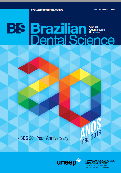Effect of the mixing method on the dimensional stability of dental stones
DOI:
https://doi.org/10.14295/bds.2018.v21i4.1616Resumo
The aim of this study was to evaluate the influence of mixing method and the empiric water/powder ratio on the dimensional change of two types of dental stones (type III and type IV) at different setting times: baseline, loss of brightness, initial and final setting (1/4 and 1pound Gilmore´s needle, respectively) and, after 48 hours at 37°C. Five mixing methods were used: Gc – manufacturer´s recommendation, G1 – weighed powder/ empiric water volume and powder on water, G2 - weighed powder/ empiric water volume and water on powder, G3 – empiric powder volume, graduated water and powder on water, G4 - empiric powder volume, graduated water and water on powder. The linear expansion was measured according to ISO 6873. The expansion values (x10-2mm) were analyzed by Two-way ANOVA and Tukey HSD test (?=0.05). For type III, the results showed significance for both factors and for interaction; for type IV, only the time were significant (p<0.05). Limited by methodology, it could be concluded that both dental stones expanded more than the recommended by ISO. The expansion of type III was dependent on the mixing method, and once correct consistency is reached with type IV, there is no influence of mixing method on dimensional stability.
Keywords
Gypsum; Dental stones; Expansion behavior.
Downloads
Downloads
Publicado
Como Citar
Edição
Seção
Licença
TRANSFERÊNCIA DE DIREITOS AUTORAIS E DECLARAÇÃO DE RESPONSABILIDADE
Toda a propriedade de direitos autorais do artigo "____________________________________________________________________" é transferido do autor(es) para a CIÊNCIA ODONTOLÓGICA BRASILEIRA, no caso do trabalho ser publicado. O artigo não foi publicado em outro lugar e não foi submetido simultaneamente para publicação em outra revista.
Vimos por meio deste, atestar que trabalho é original e não apresenta dados manipulados, fraude ou plágio. Fizemos contribuição científica significativa para o estudo e estamos cientes dos dados apresentados e de acordo com a versão final do artigo. Assumimos total responsabilidade pelos aspectos éticos do estudo.
Este texto deve ser impresso e assinado por todos os autores. A versão digitalizada deverá ser apresentada como arquivo suplementar durante o processo de submissão.




























